Abstract
With the introduction of the Microsoft Windows Storage Server 2012 offering via the IBM® Reseller Option Kit (ROK) program, clients can now get customized unified storage solutions that precisely match their specific needs. Combined with the IBM System x® servers and preinstalled by an IBM Business Partner, Windows Storage Server delivers enterprise-class storage management technology in an affordable, all-in-one solution. It is a great choice for your business regardless of whether you are a first-time user of network-attached storage (NAS) or you are deploying advanced storage solutions.
Did you know?
Windows Storage Server 2012 based unified storage with the flexible choice of storage protocols (iSCSI, SMB, NFS) can provide required performance levels for the most demanding server applications while significantly lowering deployment and support costs.
Unlike Windows Server 2012, Windows Storage Server 2012 does not require client access licenses and provides a virtually unlimited number of supported clients for storage sharing purposes.
Windows Storage Server 2012 provides flexible support for Microsoft and ISV anti-virus applications.
Solution summary
In this guide, we describe three deployment scenarios for Windows Storage Server 2012 on IBM System x hardware:
- Branch office file and print server
- Stand-alone unified storage server
- Highly available unified NAS gateway
The following table summarizes the characteristics of these three solutions.
Table 1. Solution characteristics
| Feature | Branch office file server | Stand-alone unified storage server | Highly available unified NAS gateway |
| Typical target location | Branch Office, Department | Central office | Central office |
| Storage protocols | SMB, NFS | iSCSI, SMB, NFS | iSCSI, SMB, NFS |
| Client applications | Yes | Yes | Yes |
| Server applications | No | Yes | Yes |
| Application server availability | No | Yes | Yes |
| Storage server availability | No | No | Yes |
| Scale-up storage | Limited (internal only) | Yes | No |
| Scale-out storage | No | No | Yes |
| Data deduplication | Yes | Yes | Yes |
| Snapshot copy | Yes | Yes | Yes |
| Advanced data security | Yes | Yes | Yes |
| Centralized management | Yes | Yes | Yes |
| Infrastructure services | Yes | Yes | Yes |
Business value
With enhanced manageability features, Microsoft Windows Storage Server 2012 on IBM System x reduces the time spent on IT administration, helping your business to:
- Consolidate file-sharing resources on Windows Storage Server even in mixed, heterogeneous computing environments
- Speed access to data across your entire network infrastructure, while improving control of files and compliance via a single management interface
- Take advantage of simplicity, ease of use, and low-cost scalability to leverage your organization’s current IT skills to efficiently support a growing user base
Key features and benefits provided by System x servers running Windows Storage Server 2012 include:
- An affordable and reliable unified network-attached and block-level storage solution
- A dedicated and optimized file and print server
- Microsoft Windows Storage Server 2012 has all function unrelated to file serving removed (while keeping essential infrastructure services for easier deployments), helping increase reliability and lower the overhead on the server's processor.
- Industry standard components
- A broad range of reliable storage servers built on the proven IBM System x hardware platform.
- IBM System x servers are delivered to the clients with Microsoft Windows Storage Server 2012 preinstalled by an IBM Business Partner.
- Flexible installation and deployment
- IBM's diverse portfolio of System x servers enables clients to finely tune their storage server hardware to meet cost and performance needs.
- The storage servers can be configured remotely, making them ideal for branch office, department, and store deployments.
- Easy integration into your existing IT infrastructures
- Integrates easily into Active Directory environments.
- You can use your existing management tools (such as IBM Director) and antivirus software on Windows Storage Server to protect your investments.
- Files can be shared across heterogeneous file system environments and different operating system platforms through the integration of SMB and NFS protocols.
- Compatible with existing Ethernet infrastructure.
- Easy to use and manage
- All storage tools are integrated into a single interface of Windows Server Manager.
- Centralized administration and unified user experience in managing stand-alone and clustered storage servers.
- Choice of disk and connectivity technologies
- SAS, Fibre Channel, and Ethernet options.
- Low-cost software RAID or advanced hardware-based RAID configurations.
- Potentially lower TCO
- IBM storage servers are a cost-effective storage consolidation solution in a network environment, enabling centralization of storage and storage management.
- No additional licenses are required for users, which can help to significantly reduce Client Access License costs.
- Fast data recovery
- Using the VSS for SMB File Shares feature, deleted or corrupted files can be restored within minutes, instead of hours.
- Built-in data “Snapshot” technology. Volume Shadow Copy Services (VSS) provides enhanced data protection through high-fidelity backups, rapid data restores, and data transport.
- Continuous data availability
- Failover clustering and load balancing across cluster nodes and multiple redundant network paths.
- Integration with SANs via the gateway function
Solution overview
The following figure shows the components of Windows Storage Server 2012.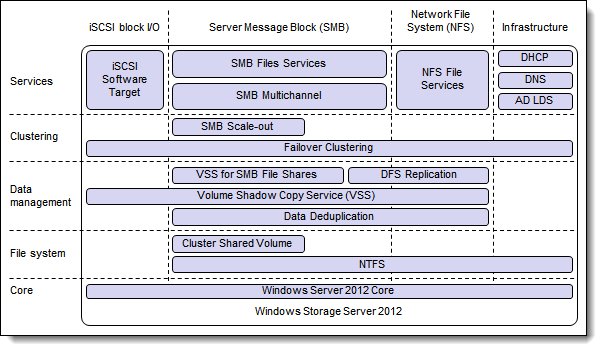
Figure 2. Windows Storage Server 2012 software components
Windows Storage Server 2012 is based on Windows Server 2012 core technologies and is optimized for providing both block- and file-level storage services to the users and server applications.
The components included in Windows Storage Server and the capabilities they provide are as follows:
Storage protocols:
- iSCSI Software Target offers low-cost shared storage for applications that require block-level access to it.
- Server Message Block (SMB) File Services provide network shares for the Windows-based user and server application environments.
- Microsoft SQL Server supports placement of log and data files onto an SMB network share (SQL over SMB).
- Microsoft Hyper-V supports placement of virtual machine files onto an SMB network share (Hyper-V over SMB).
- Network File System (NFS) File Services provide network shares for the Linux- or Mac-based user or Linux-based server application environments.
- VMware vSphere virtual machine files can be placed onto an NFS network share.
Availability and performance:
- Failover Clustering provides continuous access to the file shares and iSCSI storage.
- Transparent failover for iSCSI, SMB, and NFS connections.
- SMB Scale-out takes advantage of Cluster Shared Volume version 2 and offers active/active cluster configuration for the SMB shares by providing simultaneous access to an SMB share from any cluster node.
- Server applications that can store data onto an SMB file share (such as SQL Server or Hyper-V) can fully utilize increased network bandwidth and load-balancing capabilities of the SMB Scale-out solution.
- SMB Multichannel allows utilization of multiple redundant network paths between application server SMB clients and SMB file shares hosted on Windows Storage Servers for better throughput while maintaining network availability.
- Vendor-independent network teaming allows combining of multiple network interfaces into a single fault-tolerant or load-balancing group for better performance and availability.
- NTFS in Windows Server 2012 improves availability by performing online corruption scanning, utilizing self-healing techniques, and reducing file system repair times.
Data management:
- Data Deduplication can help to significantly improve the efficiency of storage space utilization.
- Volume Shadow Copy Service (VSS) for SMB file shares allows performing of backup operations using the snapshots of remote file shares supporting SMB-based server applications (for example, SQL over SMB).
- DFS Replication provides synchronization capabilities across limited bandwidth network connections in the distributed environments.
- BranchCache optimizes the usage of WAN links by caching the remote data locally based on predefined policies.
Infrastructure services:
- Active Directory Lightweight Directory Services (AD LDS)
- Dynamic Host Configuration Protocol (DHCP)
- Domain Name Services (DNS)
- Internet Information Services (IIS)
- Hyper-V
- Print and Document Services
Infrastructure services are essential utility services that can be deployed on Windows Storage Server itself, if they are not already present in the network, without the need to buy additional server hardware and operating system software. Windows Storage Server 2012 allows hosting of up to two virtual machines, which can serve different domains.
The following roles are supported by the Windows Storage Server 2012:
- Active Directory Lightweight Directory Services
- DHCP Server
- DNS Server
- File and Storage Services
- File Services
- File Server
- Branch Cache for Network Files
- Data Deduplication
- DFS Namespaces
- DFS Replication
- File Server Resource Manager
- File Server VSS Agent Service
- iSCSI Target Server
- Server for NFS
- Storage Services
- File Services
- Hyper-V
- Print and Document Services
- Web Server (IIS)
Windows Storage Server 2012 Standard is fulfilled via Microsoft Reseller Option Kit (ROK) program. One server license allows Windows Storage Server 2012 to be installed on a single server with up to two processors. An additional server license combined with the initial server license extends the number of sockets to four. Windows Storage Server 2012 does not require client access licenses.
The IBM Reseller Option Kit (ROK) is a software delivery option that enables distributors and resellers to order Microsoft Windows Server separately from IBM server hardware, and then preinstall it on a System x server before delivering it to the client. ROK uses BIOS-locked media that has been tuned and customized for IBM hardware, allowing for easier installation.
Solution architecture
Typical Windows Storage Server 2012 deployment scenarios include:
- Branch office file server
- Stand-alone unified storage server
- Highly available unified gateway
Branch office file server solution
In a branch office file server solution, Windows Storage Server 2012 is deployed on a stand-alone tower server, and it performs basic file serving tasks hosting SMB and NFS file shares for Windows-, Linux-, and Mac-based clients. Client applications utilize cost-efficient Gigabit Ethernet LAN infrastructure.
Data Deduplication service can be enabled on a server to allow the most efficient use of the storage space (especially for the software distribution packages, image repositories, and archives). Optionally, if the server is located at the branch office and is a part of the distributed environment, additional services such as DFS replication can be enabled to synchronize the content between the central and remote locations for the purpose of centralized backup operations (from the remote to the central location) and software delivery (from the central to the remote location).
The following figure illustrates the branch office file server solution.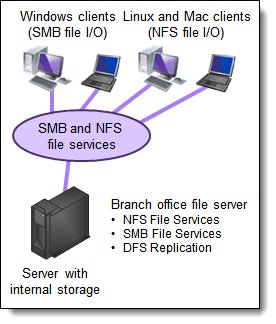
Figure 3. Branch office file server solution
For the branch office file server solution, IBM reference architecture recommends a System x3300 M4 dual-socket tower server with internal storage and running Windows Storage Server 2012 Standard.
The IBM System x3300 M4 is a high-throughput network server with excellent performance scalability when you add memory and a second processor. It incorporates the powerful Intel Xeon processor E5-2400 product family with up to 15 MB cache. The energy efficient design of the server supports two processors and 12 memory modules. It also supports either eight 3.5-inch HDDs or sixteen 2.5-inch HDDs or solid-state drives in a scalable tower or 4U rack package that is easy to service and manage. With more computing power per watt and the latest Intel Xeon processors, you can reduce costs while maintaining speed and availability.
Typical configuration of the x3300 M4 in a branch office file server solution includes:
- One processor (second processor is available as an optional upgrade if required)
- 8 GB memory
- ServeRAID C105 software RAID
- Two 500 GB SATA 3.5-inch HDDs in a mirrored pair for the operating system
- Two 2 TB SATA 3.5-inch HDDs in a mirrored pair for the up to 2 TB of usable data storage
- Two Gigabit Ethernet interfaces for the network connections
The x3300 M4 can be expanded with up to four additional 3.5-inch HDDs for a total of eight HDDs if required.
The following table shows ordering information for the IBM System x3300 M4 with Windows Storage Server 2012 in a typical configuration.
Table 2. Ordering information for the IBM System x3300 M4 with Storage Server 2012
| Part number | Description | Quantity |
| Server | ||
| 7382B2x* | x3300 M4, Xeon 4C E5-2407 80W 2.2GHz/1066MHz/10MB, 1x 4GB, O/Bay HS 3.5in, C105, DVD-ROM, 460W, Tower | 1 |
| 49Y1406 | 4GB (1x4GB, 1Rx4, 1.35V) PC3L-10600 CL9 ECC DDR3 1333MHz LP RDIMM | 1 |
| 81Y9786 | IBM 500GB 7.2K 6Gbps NL SATA 3.5in G2HS HDD | 2 |
| 81Y9794 | IBM 2TB 7.2K 6Gbps NL SATA 3.5in G2HS HDD | 2 |
| Windows Storage Server 2012 | ||
| 00Y6302 | Win Stg Srv 2012 Standard (2CPU) - English ROK | 1 |
* x in the Part number represents a country-specific letter (for example, the EMEA part number is 7382B2G, and the US part number is 7382B2U). Ask your local IBM representative for specifics.
Note: The configuration does not include a power cord, which is country-specific and must be purchased separately.
Stand-alone unified storage server
In the stand-alone unified storage server solution, Windows Storage Server 2012 is deployed on a stand-alone rack server with storage-rich capabilities (both internal storage and external scale-up storage expansion). It performs file serving tasks hosting SMB and NFS file shares for Windows-, Linux-, and Mac-based clients, SMB file shares for server applications (SQL over SMB, Hyper-V over SMB), and iSCSI storage targets for the server applications requiring block I/O. Client and server applications utilize cost-efficient Ethernet LAN infrastructure (Gigabit Ethernet or 10 GbE or mixed).
Data Deduplication service can be enabled on a server to allow the most efficient use of the storage space (especially for the software distribution packages, image repositories, and archives). Optionally, if the server is located at the central office and is a part of the distributed environment, additional services such as DFS replication can be enabled to synchronize the content between the central and remote locations for the purpose of centralized backup operations (from the remote to the central location) and software delivery (from the central to the remote location).
The following figure illustrates the stand-alone unified storage server solution.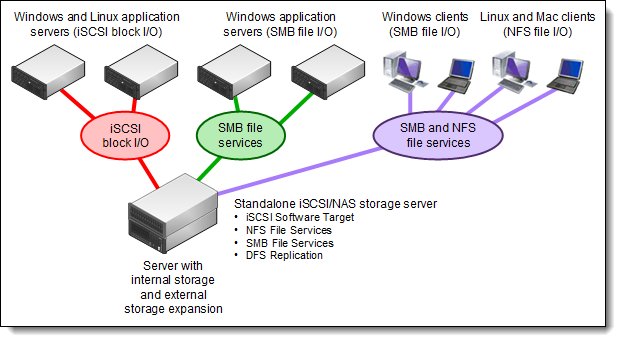
Figure 4. Stand-alone unified storage server solution
For the stand-alone unified storage server solution, IBM reference architecture recommends the System x3630 M4 dual-socket storage-rich rack server with the optional EXP2512 expansion units and running Windows Storage Server 2012 Standard.
The IBM System x3630 M4 server offers a cost-effective high-capacity storage solution with exceptional energy-smart design, leadership virtualization, and powerful systems management. It supports up to two eight-core Intel Xeon processors and high-density memory designs with twelve DDR3 DIMM slots. This 2U server consolidates storage and server into one system, offers easy management, and saves floor space and power consumption, costing less money than traditional enterprise offerings. Designed with redundancy, flexible subsystems, and a wider range of configuration options, the x3630 M4 also offers an innovative Features on Demand (FoD) design for an easier upgrade path.
Easy to manage, flexible, and extendable, the EXP2500 Express is designed to work as a direct-attach external disk solution for System x servers using ServeRAID controllers. The EXP2500 Express helps organizations enhance capacity seamlessly to address their current and future data needs. There are two EXP2500 models: EXP2512 and EXP2524. EXP2512 supports up to twelve 3.5-inch hot-swap drives, while EXP2524 supports up to twenty-four 2.5-inch hot-swap drives.
x3630 M4 and EXP2500 support solid-state drives, which can be deployed as an HDD cache with the MegaRAID CacheCade FoD upgrade available for ServeRAID M5100 Series RAID controllers, helping to increase the performance of SMB-based IOPS-intensive applications, such as SQL Server.
The following figure shows the x3630 M4 with the EXP2512 in a stand-alone unified storage server solution.
Figure 5. x3630 M4 with EXP2512 in a stand-alone unified storage server solution
Typical configuration of the x3630 M4 in a stand-alone unified storage server solution includes the following components:
- Two processors
- 32 GB memory
- One ServeRAID M5110 controller with 512 MB of flash-backed cache for the internal drives
- Two 500 GB SATA 3.5-inch HDDs in a mirrored pair for the operating system
- Four 300 GB SAS 3.5-inch HDDs in a RAID-5 for up to 900 GB of usable data storage for the server applications
- Six 2 TB SATA 3.5-inch HDDs in a RAID-5 for up to 10 TB of usable data storage for the information workers' data, software distribution packages, image repositories, and archives
- Four Gigabit Ethernet interfaces for the network connections
- One ServeRAID M5120 controller with 512 MB of flash-backed cache for the external expansion enclosure connections (one ServeRAID 5120 can host up to 18 EXP2512 expansion units for a total of 216 external 3.5-inch drives)
Typical configuration of the EXP2512 expansion unit connected to the x3630 M4 server includes the following components:
- Four 300 GB SAS 3.5-inch HDDs in a RAID-5 for up to 900 GB of usable data storage for the server applications
- Eight 2 TB SATA 3.5-inch drives in a RAID-5 for up to 14 TB of the usable data storage for the information workers' data, software distribution packages, image repositories, and archives
The following table shows ordering information for the IBM System x3630 M4 with EXP2512 and Windows Storage Server 2012 in a typical configuration.
Table 3. Ordering information for the IBM System x3630 M4, EXP2512, and Storage Server 2012
| Part number | Description | Quantity |
| Server | ||
| 7158F2x* | x3630 M4, Xeon 6C E5-2440 95W 2.4GHz/1333MHz/15MB, 1x 4GB, O/Bay HS 3.5in SATA, M5110, 750W, Rack | 1 |
| 90Y6362 | Intel Xeon Processor E5-2440 6C 2.4GHz 15MB Cache 1333MHz 95W | 1 |
| 49Y1397 | 8GB (1x8GB, 2Rx4, 1.35V) PC3L-10600 CL9 ECC DDR3 1333MHz LP RDIMM | 4 |
| 81Y9786 | IBM 500GB 7.2K 6Gbps NL SATA 3.5in G2HS HDD | 2 |
| 49Y6092 | IBM 300GB 15K 6Gbps SAS 3.5" G2HS HDD | 4 |
| 81Y9794 | IBM 2TB 7.2K 6Gbps NL SATA 3.5in G2HS HDD | 6 |
| 90Y9314 | Intel I-350 Embedded Dual Port GbE Activation for IBM System x | 1 |
| 94Y6669 | IBM System x 750W High Efficiency Platinum AC Power Supply | 1 |
| 39Y7938 | 2.8m, 10A/100-250V, C13 to IEC 320-C20 Rack Power Cable | 2 |
| External storage expansion (if required) | ||
| 81Y4478 | ServeRAID M5120 SAS/SATA Controller for IBM System x | 1 |
| 81Y4487 | ServeRAID M5100 Series 512MB Flash/RAID 5 Upgrade for IBM System x | 1 |
| 174712X | IBM System Storage® EXP2512 Express Storage™ Enclosure | 1 |
| 49Y1902 | 2TB 3.5in 7.2K 6Gb NL SAS HDD | 8 |
| 49Y1899 | 300GB 3.5in 15K 6Gb SAS HDD | 4 |
| 39R6529 | IBM 1m SAS Cable | 1 |
| Windows Storage Server 2012 | ||
| 00Y6302 | Win Stg Srv 2012 Standard (2CPU) - English ROK | 1 |
* x in the Part number represents a country-specific letter (for example, the EMEA part number is 7158F2G, and the US part number is 7158F2U). Ask your local IBM representative for specifics.
Extending the scenario, the x3630 M4 can be equipped with Emulex 10 Gb Virtual Fabric Adapters (VFAs) that support an IBM Virtual Fabric vNIC solution (split one 10 Gb port into up to four virtual ports or vNICs) and, together with the IBM RackSwitch™ G8124E, can provide bidirectional bandwidth allocation and traffic metering on a vNIC level that is based on predefined vNIC bandwidth values.
The IBM System Networking RackSwitch G8124E delivers exceptional performance that is both lossless and low latency. In addition, the G8124E delivers excellent cost savings in terms of acquisition costs and energy costs, particularly considering the feature-rich design when it comes to virtualization, CEE/FCoE, high availability, and its enterprise-class Layer 2 and Layer 3 functionality.
In the described solution, vNIC capabilities can be used to share the 10 Gb bandwidth of the VFA port among different groups (iSCSI application servers, SMB application servers, and SMB/NFS clients) while isolating the traffic from these groups and ensuring that application SLAs are met.
The following figure shows the x3630 M4 with the EXP2512 in a stand-alone unified storage server solution with the optional G8124E 10 GbE switch.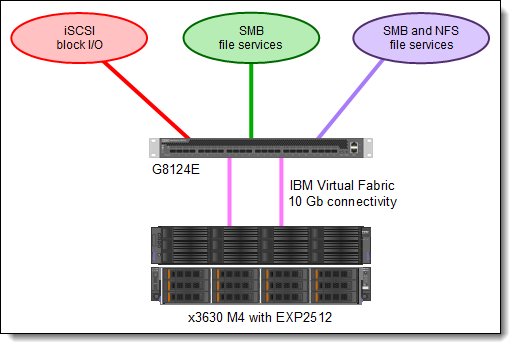
Figure 6. x3630 M4 with EXP2512 in the stand-alone unified storage server solution with the G8124E switch
Highly available unified NAS gateway
The unified gateway solution can help to lower acquisition costs for the server hardware by providing network-based highly available file storage services for the server applications without a need to connect them to costly Fibre Channel networks.
In the highly available unified gateway solution, Windows Storage Server 2012 is deployed as a failover cluster with two or more rack servers and the external shared Fibre Channel storage system. The high availability cluster performs file serving tasks hosting SMB and NFS file shares for Windows-, Linux-, and Mac-based clients, SMB file shares for server applications (SQL over SMB, Hyper-V over SMB), and iSCSI storage targets for the server applications requiring block I/O.
Client and server applications utilize cost-efficient redundant Ethernet LAN infrastructure (Gigabit Ethernet or 10 GbE or mixed). SMB Scale-out and SMB Multichannel provide performance improvement for the SMB I/O server applications with load balancing across cluster nodes and redundant network links.
Data Deduplication service can be enabled on a server to allow the most efficient use of the storage space (especially for the software distribution packages, image repositories, and archives). Optionally, if the cluster is located at the central office and is a part of the distributed environment, additional services, such as DFS replication can be enabled to synchronize the content between the central and remote locations for the purpose of centralized backup operations (from the remote to the central location) and software delivery (from the central to the remote location).
The following figure illustrates the highly available unified gateway solution.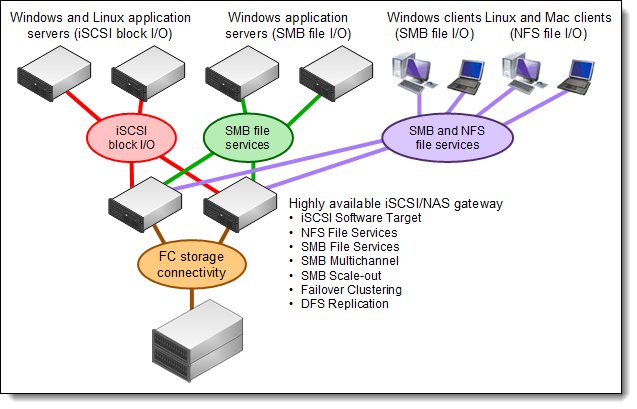
Figure 7. Highly available unified NAS gateway solution
For the highly available unified NAS gateway solution, IBM reference architecture recommends two or more System x3530 M4 dual-socket rack servers running Windows Storage Server 2012 Standard and connected to the IBM Storwize® V5000 storage system.
With up to four servers, all of the servers can be directly connected to the Storwize V5000 storage system. If more than four servers are required to be connected to the FC storage, the IBM external FC SAN switch needs to be added to the configuration.
The IBM System x3530 M4 server delivers dual-socket performance in a 1U compact footprint. Featuring the latest Intel Romley EN platform, the x3530 M4 is a flexible rack server positioned as a good investment value when considering your total cost of ownership (TCO) and IBM commitment. It is designed to provide more affordable value and increased flexibility with performance and quality to match. Designed with redundancy, flexible subsystems, and a wide range of configuration options, the x3530 M4 also offers an innovative Feature on Demand (FoD) design for an easier upgrade path.
Storwize V5000, the most recent addition to the IBM Storwize family of disk systems, is designed to provide midsized organizations with a flexible, easy to use, and efficient storage solution to help simplify consolidation and data management while providing advanced functionality. Built upon innovative IBM technology, Storwize V5000 addresses the block storage requirements of small and midsize organizations and accommodates the most common storage network technologies to enable easy implementation and management.
The following figure shows the x3530 M4 and Storwize V5000 in a highly available unified gateway solution.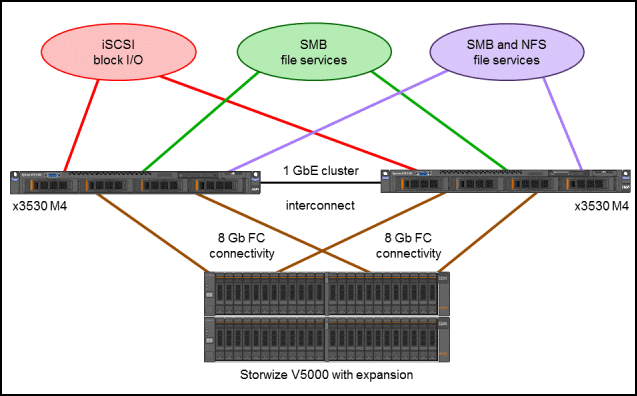
Figure 8. x3530 M4 and Storwize V5000 in a highly available unified gateway solution
Typical configuration of each of the two x3530 M4 servers in the highly available unified gateway solution includes these components:
- Two processors
- 48 GB memory
- ServeRAID C105 software RAID controller for the internal drives
- Two 500 GB SATA 3.5-inch HDDs in a mirrored pair for the operating system
- Four Gigabit Ethernet interfaces for the network connections
- One dual-port 8 Gb Fibre Channel adapter for the Storwize V5000 connections
Typical configuration of the Storwize V5000 with the expansion unit includes these components:
- Two controllers
- Four external 8 Gb FC ports per controller
- Twelve 300 GB 15K rpm SAS 2.5-inch HDDs in a RAID-5 for up to 3.3 TB of usable data storage for the server applications
- Twelve 146 GB 15K rpm SAS 2.5-inch HDDs in a RAID-5 for up to 1.6 TB of usable data storage for the high-performance server applications
- Twelve 2 TB NL HDD 3.5-inch drives in a RAID-5 for up to 14 TB of the usable data storage for the information workers' data, software distribution packages, image repositories, and archives
The following table shows ordering information for the IBM System x3530 M4, Storwize V5000, and Windows Storage Server 2012 in a typical configuration.
Table 4. Ordering information for the IBM System x3530 M4, Storwize V5000, and Storage Server 2012
| Part number/MTM/ Feature code | Description | Quantity |
| Server | ||
| 7160C2x* | x3530 M4, Xeon 6C E5-2420 95W 1.9GHz/1333MHz/15MB, 1x 4GB, 0/Bay HS 3.5in SAS/SATA, C105, 460W, Rack | 2 |
| 94Y6378 | Intel Xeon Processor E5-2420 6C 1.9GHz 15MB Cache 1333MHz 95W | 2 |
| 49Y1397 | 8GB (1x8GB, 2Rx4, 1.35V) PC3L-10600 CL9 ECC DDR3 1333MHz LP RDIMM | 12 |
| 81Y9786 | IBM 500GB 7.2K 6Gbps NL SATA 3.5in G2HS HDD | 4 |
| 42D0510 | QLogic 8Gb FC Dual-port HBA for IBM System x | 2 |
| 90Y9314 | Intel I-350 Embedded Dual Port GbE Activation for IBM System x | 2 |
| 00D4413 | 460W Power Supply (Redundant) | 2 |
| 39Y7938 | 2.8m, 10A/100-250V, C13 to IEC 320-C20 Rack Power Cable | 2 |
| External shared storage | ||
| 2077-24C | IBM Storwize V5000 SFF Dual Control Enclosure | 1 |
| AC51 | 300GB 2.5in 15K rpm SAS HDD | 12 |
| AC50 | 146GB 2.5in 15K rpm SAS HDD | 12 |
| AC05 | 8Gb FC 4 Port Host Interface Card | 2 |
| 2078-12E | IBM Storwize V5000 LFF Expansion Enclosure | 1 |
| AC30 | 2TB 3.5in 7.2K rpm SAS NL HDD | 12 |
| 5305 | 5m Fiber Optic Cable LC-LC | 4 |
| ACTA | 0.6m SAS Cable (mSAS HD) | 2 |
| Windows Storage Server 2012 | ||
| 00Y6302 | Win Stg Srv 2012 Standard (2CPU) - English ROK | 2 |
* x in the part number represents a country-specific letter (for example, the EMEA part number is 7160C2G, and the US part number is 7160C2U). Ask your local IBM representative for specifics.
Extending the scenario, x3530 M4 can be equipped with Emulex 10 Gb Virtual Fabric Adapters (VFAs) that support an IBM Virtual Fabric vNIC solution (split one
10 Gb port into up to four virtual ports or vNICs) and, together with the IBM RackSwitch G8124E, can provide bidirectional bandwidth allocation and traffic metering on a vNIC level that is based on predefined vNIC bandwidth values.
The IBM System Networking RackSwitch G8124E delivers exceptional performance that is both lossless and low latency. In addition, the G8124E delivers excellent cost savings in terms of acquisition costs and energy costs, particularly considering the feature-rich design when it comes to virtualization, CEE/FCoE, high availability, and its enterprise-class Layer 2 and Layer 3 functionality.
In the described solution, vNIC capabilities can be used to share the 10 Gb bandwidth of the VFA port among different groups (iSCSI application servers, SMB application servers, and SMB/NFS clients) while isolating the traffic from these groups and ensuring that application SLAs are met.
The following figure shows the x3530 M4, Storwize V5000, and G8124E in the highly available unified gateway solution.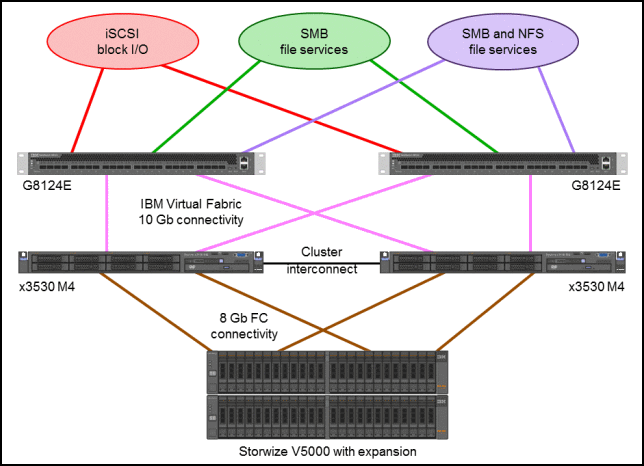
Figure 9. x3530 M4, Storwize V5000, and G8124E in the highly available unified gateway solution
Related product families
Product families related to this document are the following:
Trademarks
Lenovo and the Lenovo logo are trademarks or registered trademarks of Lenovo in the United States, other countries, or both. A current list of Lenovo trademarks is available on the Web at https://www.lenovo.com/us/en/legal/copytrade/.
The following terms are trademarks of Lenovo in the United States, other countries, or both:
Lenovo®
System x®
The following terms are trademarks of other companies:
Intel®, the Intel logo and Xeon® are trademarks of Intel Corporation or its subsidiaries.
Linux® is the trademark of Linus Torvalds in the U.S. and other countries.
Microsoft®, Active Directory®, BranchCache®, Hyper-V®, SQL Server®, Windows Server®, and Windows® are trademarks of Microsoft Corporation in the United States, other countries, or both.
IBM®, ibm.com®, and Storwize® are trademarks of IBM in the United States, other countries, or both.
Other company, product, or service names may be trademarks or service marks of others.
